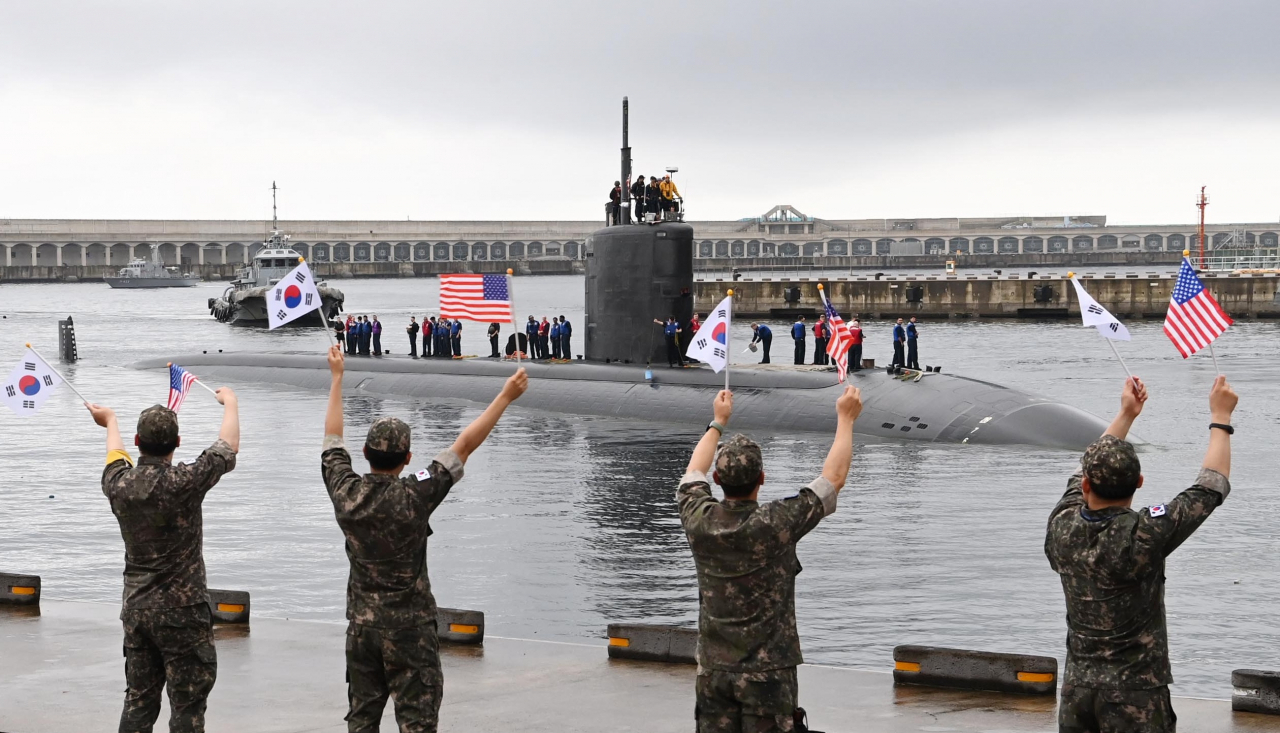 |
The US Navy's Los Angeles-class attack submarine USS Annapolis enters the South Korean naval base at Jeju Island on Monday morning. (Photo - Republic of Korea Navy) |
A US Navy nuclear-powered submarine entered the South Korean naval base on Jeju Island on Monday morning to replenish military supplies during an operational mission, South Korea’s Navy said in a statement.
South Korean and US navies have also been discussing staging combined military exercises such as an anti-submarine warfare exercise during the visit by the US submarine, a military official who wished to remain anonymous told The Korea Herald.
The main mission of Los Angeles-class fast attack submarine USS Annapolis is to carry out anti-ship and anti-submarine warfare by seeking and destroying enemy submarines and surface ships.
Last September, the USS Annapolis participated in a trilateral anti-submarine warfare exercise conducted by the South Korean and US navies and the Japan Maritime Self-Defense Force in international waters of the East Sea. The exercise was designed to strengthen interoperabilities and capabilities to counter mounting submarine threats posed by North Korea.
"The South Korean and US navies will strengthen their combined defense posture and conduct exchange activities to commemorate the 70th anniversary of the South Korea-US alliance on the occasion of the USS Annapolis’ port visit," the South Korean Navy said.
The dispatch of the USS Annapolis to the peninsula came three days after the US Navy’s Ohio-class USS Kentucky made a four-day port visit to Busan that ended Friday. It is the first deployment of the US submarine -- which is capable of launching ballistic missiles with nuclear warheads -- in Korea since the early 1980s.
In an apparent protest to the deployment of the US strategic asset, North Korea fired two ballistic missiles from the capital city of Pyongyang toward the East Sea early Wednesday. The missile flew around 550 kilometers, equidistant from Pyongyang to the Busan port.
North Korea also fired several cruise missiles toward its western coast early on Saturday.
North Korea's Defense Minister Kang Sun-nam on Thursday issued a warning that the growing presence of nuclear-capable submarines and other US strategic assets in the region could potentially be met with the conditions specified in North Korean law concerning the use of nuclear weapons.
But unlike the Ohio-class, which consists of nuclear-capable ballistic missile submarines and cruise missile submarines and are classified as US strategic assets, the Los Angeles-class nuclear-powered submarines do not hold the same designation.
The fast attack submarine USS Annapolis is capable of launching Tomahawk Land Attack Missiles, which are long-range cruise missiles used for deep land attack warfare. However, it no longer carries nuclear weapons, despite being armed with nuclear-tipped cruise missiles during the Cold War era.
Nevertheless, they serve as the backbone of the US Submarine Force, owing to their technological superiority, speed, endurance, mobility, stealth and payload capacity, which collectively enable them to maintain preeminence in undersea battlespace.
Choi Il, a retired South Korean submarine captain, said that the port visit of the US submarine to Jeju Island indicates the US' intention to diversify the naval bases its submarines visit within South Korea, moving away from the traditional practice of exclusively visiting naval bases in the cities of Jinhae, South Gyeongsang Province, and Busan.
The naval base on Jeju Island has significant geographical advantages as it allows for quick deployment towards international waters. Additionally, it provides better cover compared to the bases in Busan and Jinhae.
"Through the recent entry to the Jeju base, the US Navy can gain experience in entering and departing the base and test the effectiveness of locally replenishing military supplies in preparation for war," Choi said.
Choi forecasts that "US submarines are likely to visit Korean naval bases more frequently, for a greater variety of reasons, and at a more diverse range of bases."







![[Today’s K-pop] Blackpink’s Jennie, Lisa invited to Coachella as solo acts](http://res.heraldm.com/phpwas/restmb_idxmake.php?idx=644&simg=/content/image/2024/11/21/20241121050099_0.jpg)